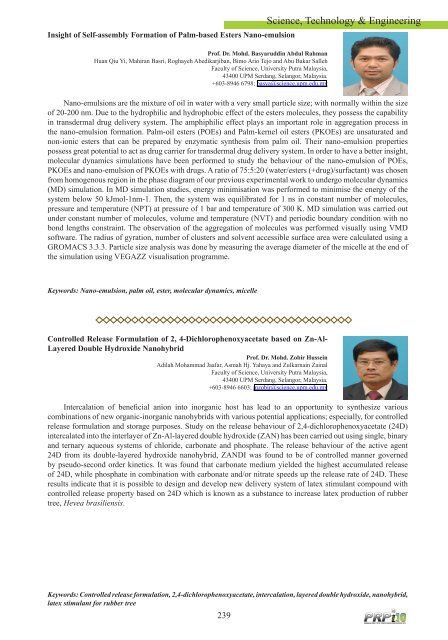BUKU ABSTRAK - Universiti Putra Malaysia
BUKU ABSTRAK - Universiti Putra Malaysia
BUKU ABSTRAK - Universiti Putra Malaysia
Create successful ePaper yourself
Turn your PDF publications into a flip-book with our unique Google optimized e-Paper software.
Insight of Self-assembly Formation of Palm-based Esters Nano-emulsion<br />
Prof. Dr. Mohd. Basyaruddin Abdul Rahman<br />
Huan Qiu Yi, Mahiran Basri, Roghayeh Abedikarjiban, Bimo Ario Tejo and Abu Bakar Salleh<br />
Faculty of Science, University <strong>Putra</strong> <strong>Malaysia</strong>,<br />
43400 UPM Serdang, Selangor, <strong>Malaysia</strong>.<br />
+603-8946 6798; basya@science.upm.edu.my<br />
Keywords: Nano-emulsion, palm oil, ester, molecular dynamics, micelle<br />
Controlled Release Formulation of 2, 4-Dichlorophenoxyacetate based on Zn-Al-<br />
Layered Double Hydroxide Nanohybrid<br />
Prof. Dr. Mohd. Zobir Hussein<br />
Adilah Mohammad Jaafar, Asmah Hj. Yahaya and Zulkarnain Zainal<br />
Faculty of Science, University <strong>Putra</strong> <strong>Malaysia</strong>,<br />
43400 UPM Serdang, Selangor, <strong>Malaysia</strong>.<br />
+603-8946 6603; mzobir@science.upm.edu.my<br />
239<br />
Science, Technology & Engineering<br />
Nano-emulsions are the mixture of oil in water with a very small particle size; with normally within the size<br />
of 20-200 nm. Due to the hydrophilic and hydrophobic effect of the esters molecules, they possess the capability<br />
in transdermal drug delivery system. The amphiphilic effect plays an important role in aggregation process in<br />
the nano-emulsion formation. Palm-oil esters (POEs) and Palm-kernel oil esters (PKOEs) are unsaturated and<br />
non-ionic esters that can be prepared by enzymatic synthesis from palm oil. Their nano-emulsion properties<br />
possess great potential to act as drug carrier for transdermal drug delivery system. In order to have a better insight,<br />
molecular dynamics simulations have been performed to study the behaviour of the nano-emulsion of POEs,<br />
PKOEs and nano-emulsion of PKOEs with drugs. A ratio of 75:5:20 (water/esters (+drug)/surfactant) was chosen<br />
from homogenous region in the phase diagram of our previous experimental work to undergo molecular dynamics<br />
(MD) simulation. In MD simulation studies, energy minimisation was performed to minimise the energy of the<br />
system below 50 kJmol-1nm-1. Then, the system was equilibrated for 1 ns in constant number of molecules,<br />
pressure and temperature (NPT) at pressure of 1 bar and temperature of 300 K. MD simulation was carried out<br />
under constant number of molecules, volume and temperature (NVT) and periodic boundary condition with no<br />
bond lengths constraint. The observation of the aggregation of molecules was performed visually using VMD<br />
software. The radius of gyration, number of clusters and solvent accessible surface area were calculated using a<br />
GROMACS 3.3.3. Particle size analysis was done by measuring the average diameter of the micelle at the end of<br />
the simulation using VEGAZZ visualisation programme.<br />
Intercalation of beneficial anion into inorganic host has lead to an opportunity to synthesize various<br />
combinations of new organic-inorganic nanohybrids with various potential applications; especially, for controlled<br />
release formulation and storage purposes. Study on the release behaviour of 2,4-dichlorophenoxyacetate (24D)<br />
intercalated into the interlayer of Zn-Al-layered double hydroxide (ZAN) has been carried out using single, binary<br />
and ternary aqueous systems of chloride, carbonate and phosphate. The release behaviour of the active agent<br />
24D from its double-layered hydroxide nanohybrid, ZANDI was found to be of controlled manner governed<br />
by pseudo-second order kinetics. It was found that carbonate medium yielded the highest accumulated release<br />
of 24D, while phosphate in combination with carbonate and/or nitrate speeds up the release rate of 24D. These<br />
results indicate that it is possible to design and develop new delivery system of latex stimulant compound with<br />
controlled release property based on 24D which is known as a substance to increase latex production of rubber<br />
tree, Hevea brasiliensis.<br />
Keywords: Controlled release formulation, 2,4-dichlorophenoxyacetate, intercalation, layered double hydroxide, nanohybrid,<br />
latex stimulant for rubber tree



